Heritage Sites in Uttarakhand
Planning your heritage exploration? We've documented 12 heritage sites in uttarakhand spanning diverse architectural styles. From UNESCO World Heritage Sites to hidden gems, find your next heritage adventure with detailed visitor information, best times to visit, entry fees, and local insights. Each site features comprehensive documentation to help you plan an enriching cultural journey.
12 sites with visitor information
2 UNESCO World Heritage Sites
12 must-visit iconic sites
Detailed travel guides and local tips
Total Sites:12
UNESCO Sites:2
ASI Protected:3
Top Category:Temple (10)
Top Style:Nagara Architecture + Hindu Temple + Sloping roofs, stone walls (1)
Top Period:Gurjara-Pratihara Period (4)
12
Total Sites
2
UNESCO Sites
3
ASI Protected
12
Featured
12 Sites Found
Featured
Mall Road, Almora, Almora (263601), Uttarakhand, India, Uttarakhand
The crisp mountain air of Almora carried whispers of history as I approached the imposing remains of Almora Fort, perched atop a ridge overlooking the sprawling valley. Unlike the colossal granite behemoths of South India I’m accustomed to, this fort, also known as the Kote Ka Ghar, presented a different kind of grandeur. The relatively modest scale, constructed primarily with locally quarried quartzite stone, spoke to a more intimate, localized power, a stark contrast to the imperial ambitions reflected in the Vijayanagara fortifications I’ve extensively studied. The fort's current state is fragmented, a scattering of remnants hinting at its former glory. The most prominent feature is the imposing eastern gate, a testament to the fort's defensive strategy. The archway, constructed with dressed stone blocks, exhibits a simple yet robust architectural style. While lacking the intricate carvings and sculptures that adorn South Indian gateways, the sheer thickness of the walls and the strategic placement conveyed a sense of impregnability. I noticed the absence of elaborate flanking towers or bastions, suggesting a reliance on the natural topography for defense, a characteristic I’ve observed in several hill forts across India. Passing through the gate, I found myself in a large open space, now overgrown with grass and dotted with a few scattered structures. Local vendors had set up stalls, selling trinkets and refreshments, adding a layer of contemporary life to the historical backdrop. This integration of the past and present, while common in many heritage sites, felt particularly poignant here. It wasn't a jarring juxtaposition, but rather a seamless blend, a testament to the fort's continued relevance in the community. The most intriguing architectural element I encountered was the remains of what appeared to be a palace or administrative building. The foundation and lower walls, constructed with large, roughly hewn stone blocks, suggested a multi-storied structure. The use of pointed arches in some sections hinted at a later Mughal influence, possibly during the reign of the Chand dynasty who controlled the fort after the Katyuri kings. This architectural amalgamation, a fusion of local building techniques with external influences, is a recurring theme in Indian architecture, reflecting the ebb and flow of power and cultural exchange. I was particularly drawn to the subtle details: the worn grooves in the stone steps, likely carved by centuries of foot traffic; the remnants of plasterwork on the walls, offering a glimpse into the fort's decorative past; the strategically placed openings offering breathtaking panoramic views of the valley below. These seemingly insignificant details whispered stories of daily life within the fort walls, stories of soldiers, administrators, and perhaps even royalty. My South Indian sensibilities were constantly drawn to the differences. The absence of elaborate water management systems, a hallmark of South Indian temple complexes and forts, was particularly striking. The relatively dry climate of Almora perhaps negated the need for complex tanks and channels. The construction techniques also differed significantly. The dry stone masonry prevalent in Almora Fort contrasted sharply with the intricate interlocking stonework and mortar usage common in South Indian architecture. Standing on the ramparts, gazing at the snow-capped peaks in the distance, I felt a profound sense of connection to the past. Almora Fort, though different in style and scale from the architectural marvels I'm familiar with, resonated with the same spirit of resilience, ingenuity, and adaptation. It served as a powerful reminder that architectural heritage is not merely about grand monuments but also about the stories they tell, the whispers of history carried on the mountain breeze. It’s a testament to the human endeavor to leave a mark on the landscape, a mark that endures even as empires rise and fall.
Fort
British Colonial Period

Featured
80% Documented
Badrinath Road, Chamoli, Badrinath (246422), Uttarakhand, India, Uttarakhand
The biting Himalayan air, thin and crisp, whipped prayer flags into a frenzy of colour against the backdrop of the snow-dusted Neelkanth peak. This is Badrinath, nestled within the formidable embrace of the Garhwal Himalayas, a place where the spiritual and the sublime converge. As I stood before the Badrinath Temple, the culmination of my journey to every UNESCO site in India, I felt a palpable shift, a sense of arrival not just at a destination, but at a nexus of faith and fortitude. The temple, dedicated to Lord Vishnu, isn't imposing in its scale like some of the South Indian behemoths I've documented. Instead, it exudes a quiet strength, a resilience honed by centuries of harsh weather and unwavering devotion. Its architecture, characteristic of the North Indian style, features a brightly coloured facade, dominated by an arched gateway crowned with a small cupola. The walls are relatively plain, save for intricate carvings around the windows and doorways, depicting scenes from Hindu mythology. What struck me most was the contrast: the vibrant, almost festive exterior against the stark, monochromatic landscape. It's as if the temple itself is a defiant burst of colour in a world of grey and white. Entering the sanctum sanctorum was an experience in sensory overload. The air, thick with the scent of incense and ghee, vibrated with the rhythmic chanting of priests. The dimly lit space, illuminated by flickering oil lamps, focused all attention on the black stone idol of Lord Vishnu, serenely seated in the padmasana pose. Unlike the elaborate rituals I've witnessed in other temples, the puja here felt intimate, personal. Perhaps it was the confined space, the close proximity to the deity, or the palpable devotion of the pilgrims, but I felt a connection, a sense of shared reverence that transcended the usual tourist experience. Beyond the main shrine, the temple complex houses several smaller shrines dedicated to various deities. I spent some time exploring these, each unique in its own right, each whispering tales of ancient legends and local beliefs. The Tapt Kund, a thermal spring located near the temple, is another highlight. Braving the near-freezing temperatures, I took a dip in the sulfur-rich waters, a ritual considered sacred by pilgrims. The experience, while invigorating, was a stark reminder of the harsh realities of life at this altitude. One of the most fascinating aspects of Badrinath is its connection to the surrounding landscape. The Alaknanda River, roaring past the temple, is considered sacred, and the surrounding peaks, each with its own mythological significance, form a natural amphitheater. I spent hours simply absorbing the scenery, trying to capture the essence of this place through my lens. The sheer scale of the mountains, the raw power of the river, and the quiet resilience of the temple created a visual symphony that resonated deep within me. My visit to Badrinath wasn't just about documenting another UNESCO site; it was a pilgrimage of sorts, a journey into the heart of the Himalayas, to a place where faith and nature intertwine. It was a humbling experience, a reminder of the enduring power of belief and the profound connection between humans and the natural world. As I descended from the heights of Badrinath, I carried with me not just photographs and memories, but a renewed appreciation for the rich tapestry of India's cultural and natural heritage. This is a place that stays with you, a place that calls you back, not just to witness its beauty, but to experience its soul.
Temple
North Indian Temple Style
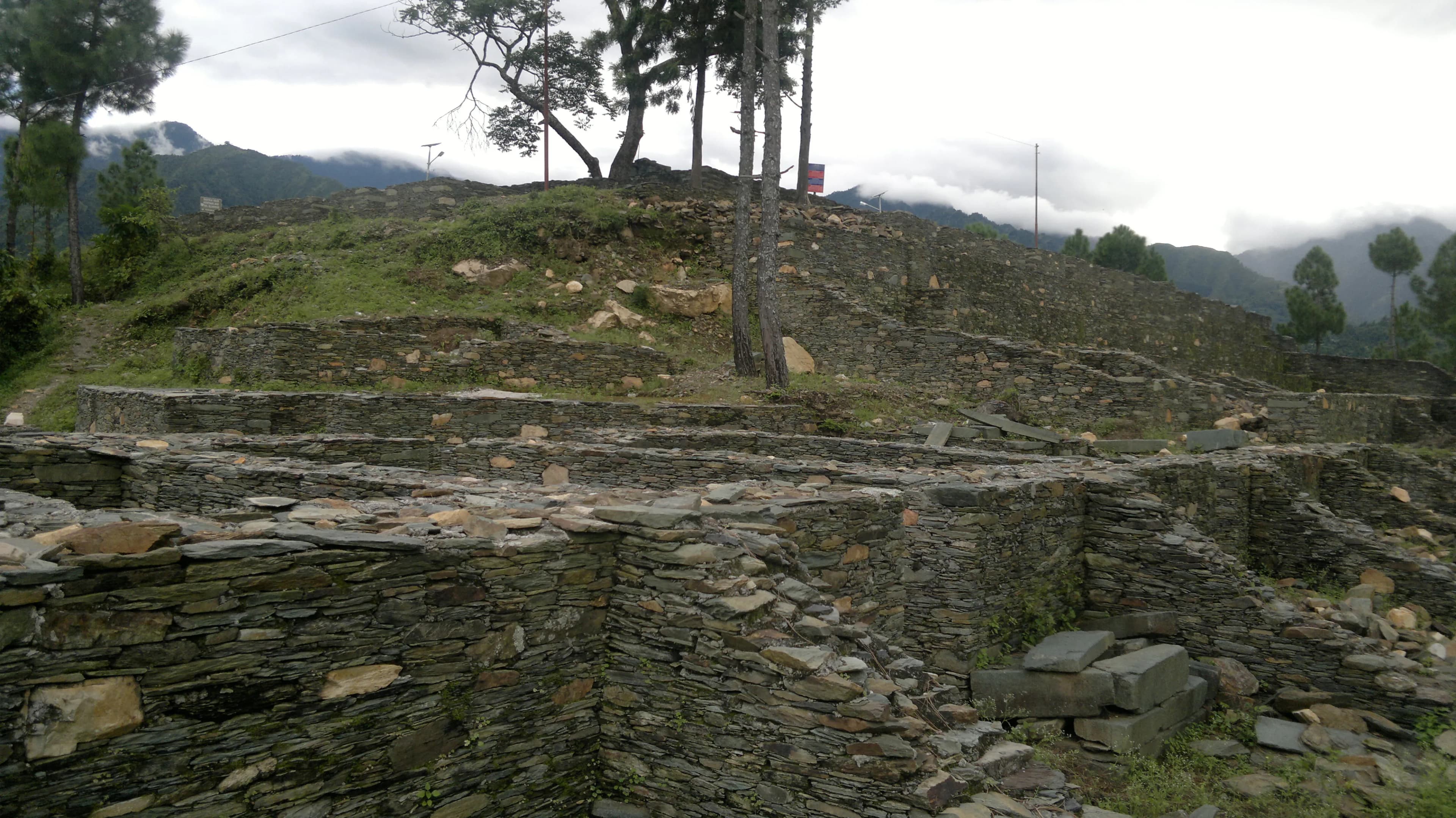
Featured
Chandpur Garhi, Tehri Garhwal, Narendranagar (249175), Uttarakhand, India, Uttarakhand
The wind whipped around me, carrying whispers of history as I stood atop Chandpur Garhi fort, gazing across the sprawling Tehri Garhwal landscape. The fort, a silent sentinel perched on a hilltop, commanded a breathtaking panorama of the Bhagirathi valley, a view that must have been strategically invaluable to its past rulers. It wasn't difficult to imagine the fort in its prime, bustling with activity, a formidable stronghold against invaders. My journey to Chandpur Garhi had been arduous, a winding climb up a steep, narrow road. But the first glimpse of the fort, its imposing ramparts silhouetted against the clear mountain sky, made the effort worthwhile. The fort, primarily constructed of locally quarried stone, displayed a rugged, almost organic architecture, blending seamlessly with the surrounding terrain. The stonework, though weathered by centuries of exposure, retained a remarkable integrity, a testament to the skill of the original builders. Entering the fort through a massive arched gateway, I was struck by the sheer scale of the complex. The interior was a labyrinth of interconnected courtyards, chambers, and passageways, each whispering tales of a bygone era. The remnants of residential quarters, stables, and storage areas spoke of a once thriving community within these walls. I noticed intricate carvings adorning some of the stonework, delicate floral patterns and geometric designs that hinted at a refined aesthetic sensibility. These details, often overlooked, provided a glimpse into the cultural richness of the fort's inhabitants. One of the most striking features of Chandpur Garhi is its intricate water management system. Several large cisterns, strategically placed within the complex, collected rainwater, ensuring a continuous supply for the fort's occupants. The ingenuity of this system, particularly in such a challenging environment, is truly remarkable. I spent considerable time photographing these cisterns, fascinated by their construction and the foresight they represented. The central courtyard, the heart of the fort, offered a panoramic view of the surrounding hills. Here, I could almost hear the echoes of past battles, the clash of swords, and the thunder of hooves. The strategic placement of the fort, offering clear lines of sight in all directions, underscored its military importance. I could visualize sentries patrolling the ramparts, ever vigilant against potential threats. As I explored further, I discovered a small, almost hidden temple dedicated to the local deity. The temple, though simple in its design, possessed a quiet serenity, a stark contrast to the martial atmosphere of the rest of the fort. The presence of this sacred space within the fort walls highlighted the importance of religious beliefs in the lives of the people who once lived here. The light began to fade, casting long shadows across the ancient stones. As I prepared to descend, I paused for one last look at Chandpur Garhi. The fort, bathed in the warm glow of the setting sun, seemed to exude a timeless aura, a tangible link to a rich and complex past. My time at Chandpur Garhi was more than just a photographic expedition; it was a journey through time, an immersive experience that allowed me to connect with the history and heritage of this remarkable place. The images I captured, I hope, will serve as a testament to the enduring legacy of Chandpur Garhi, a silent witness to the ebb and flow of history in the heart of the Himalayas. The fort stands not just as a testament to architectural ingenuity but as a poignant reminder of the power of place and the stories etched within its ancient stones. It is a place that deserves to be explored, understood, and preserved for generations to come.
Fort
Gurjara-Pratihara Period

Featured
80% Documented
Golu Devta Temple Road, Almora, Chitai (263626), Uttarakhand, India, Uttarakhand
The crisp mountain air vibrated with the faint clang of countless bells. I stood before the Chitai Golu Devta Temple, nestled amidst the verdant hills of Almora, Uttarakhand, a place where faith takes a tangible, almost audible form. Unlike the ornate stone carvings and towering shikharas of many North Indian temples, Chitai Golu Devta presents a simpler, more rustic aesthetic. The main temple structure, while architecturally modest, is completely enveloped, almost suffocated, by a dense tapestry of bells. Thousands upon thousands of them, in every size imaginable, from tiny tinkling trinkets to hefty, resonant giants, hang from every available surface – the roof eaves, the doorways, the railings, even the branches of the surrounding trees. This visual symphony of bronze and brass, glinting in the Himalayan sunlight, is a testament to the unwavering faith of the devotees who offer these bells as symbols of their fulfilled wishes. The deity, Golu Devta, is a manifestation of Lord Shiva, revered as the dispenser of justice. This aspect is immediately apparent in the countless letters tied to the temple walls, each a whispered plea, a desperate hope, a heartfelt prayer for intervention. These letters, yellowed and weathered by time and elements, form a poignant narrative of human struggles, desires, and unwavering belief. They are not merely pieces of paper; they are tangible representations of the emotional weight carried by those who visit this sacred site. I spent a considerable amount of time photographing these letters, trying to capture not just their physical presence but also the silent stories they held within their folds. The temple complex itself is a multi-tiered structure, with the main shrine housing the deity at the center. The architecture is relatively simple, with sloping slate roofs and whitewashed walls, allowing the vibrant tapestry of bells to take center stage. The courtyard, paved with uneven stones worn smooth by countless footsteps, is always bustling with activity. Devotees offer prayers, tie their bells, and write their letters, their faces etched with a mixture of hope and reverence. The air is thick with the scent of incense and the murmur of prayers, creating an atmosphere that is both chaotic and deeply spiritual. What struck me most about Chitai Golu Devta was the palpable sense of connection between the devotees and the deity. This wasn't just a place of worship; it was a living, breathing testament to the power of faith. I observed a young girl carefully tying a small bell to a railing, her eyes closed in silent prayer. An elderly man, his face lined with years of experience, meticulously wrote a letter, his hand trembling slightly. A family, their faces beaming with joy, offered a large bell, its resonant clang echoing through the valley. Each act of devotion, however small, contributed to the unique energy of this place. As a heritage photographer, I'm often drawn to the grandeur and intricate details of ancient monuments. However, Chitai Golu Devta offered a different kind of beauty, a beauty born not of architectural prowess but of the sheer weight of human faith. The temple, in its relative simplicity, serves as a blank canvas for the vibrant tapestry of bells and letters, each a testament to the enduring power of belief. The experience was humbling, a reminder that sometimes, the most powerful stories are not etched in stone but whispered in the clang of a bell or written on a faded piece of paper. Leaving Chitai Golu Devta, I carried with me not just photographs but a profound sense of the human spirit's enduring capacity for hope and faith, resonating like the lingering chime of a thousand bells.
Temple
British Colonial Period
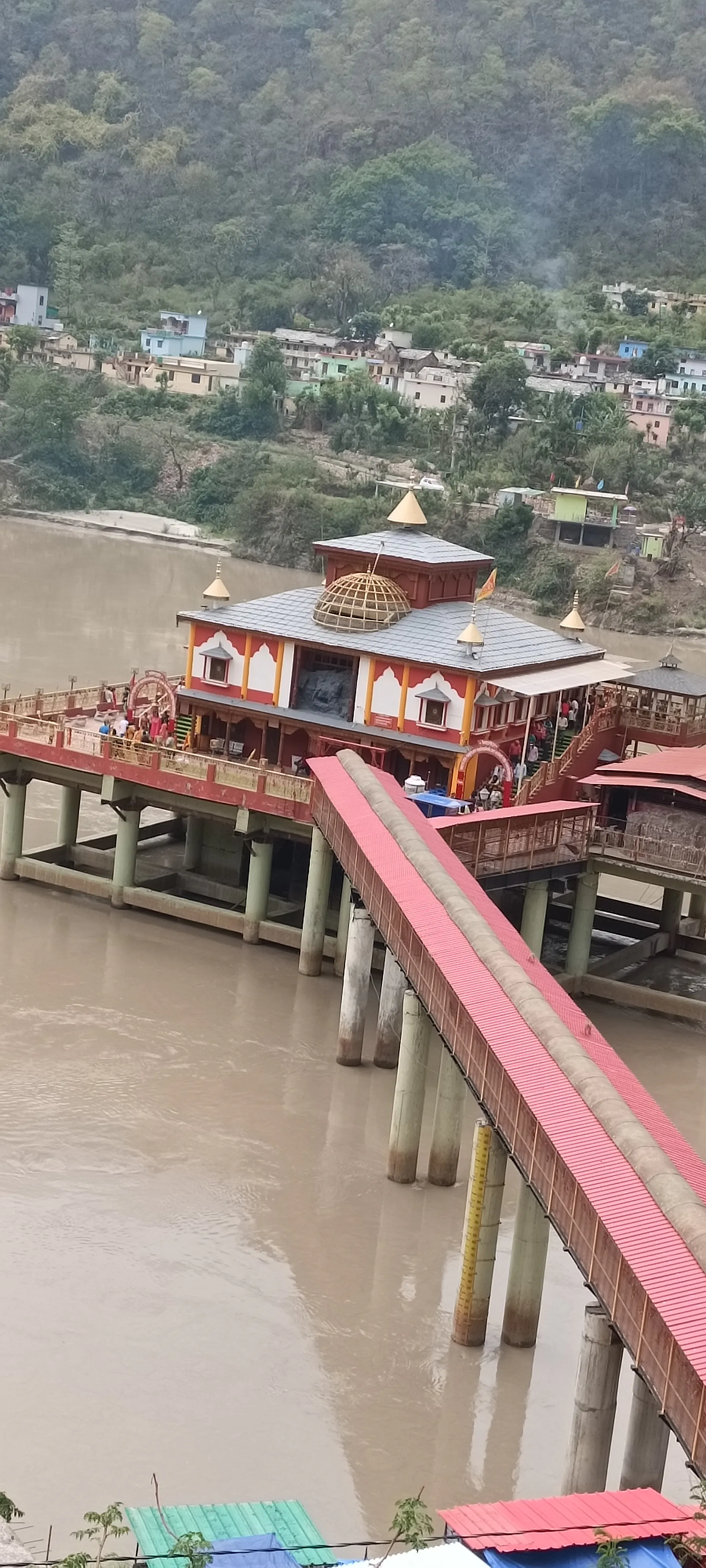
Featured
80% Documented
Dhari Devi, Pauri Garhwal, Srinagar (246174), Uttarakhand, India, Uttarakhand
The roar of the Alaknanda River was a constant companion as I made my way to the Dhari Devi Temple, perched precariously on a cliff edge near Srinagar in Uttarakhand. This wasn't just another temple on my list of 500+ documented Indian monuments; it was a place steeped in legend, a place where the very air seemed to vibrate with a palpable energy. The temple, dedicated to the guardian deity Kali in her Dhari avatar, felt intrinsically linked to the river itself, almost as if the rushing waters were an extension of the goddess's power. The first thing that struck me was the temple's unique architecture, or rather, the lack of a conventional structure. Unlike the grand stone edifices I'd encountered elsewhere, Dhari Devi's main shrine is essentially a small open-air platform built into the cliff face. This simplicity, however, only amplified the sense of raw, untamed devotion. The idol of Dhari Devi, traditionally adorned in bright red garments and elaborate silver ornaments, is the focal point. It's a stark, powerful image – the goddess seemingly emerging directly from the rock, her gaze fixed on the churning waters below. Local lore dictates that the goddess's face changes throughout the day, morphing from a girl to a woman and finally to an old crone. While I couldn't personally attest to this phenomenon during my limited time there, the very existence of such a belief speaks volumes about the deep-rooted reverence and the air of mystery surrounding the deity. I spent hours observing the rituals, captivated by the rhythmic chanting of the priests and the unwavering faith of the devotees. The offerings, primarily flowers and fruits, were simple yet heartfelt. What struck me most was the palpable connection between the worshippers and the natural surroundings. The river, the mountains, the temple – they all seemed to coalesce into a single, sacred entity. My photographic lens focused on capturing the interplay of light and shadow on the goddess's face, the vibrant colours of the offerings against the muted tones of the rock, and the expressions of devotion etched on the faces of the pilgrims. I tried to capture not just the physicality of the temple but also the intangible aura that permeated the space. The temple's location itself adds another layer of intrigue. Perched on the edge of the Alaknanda, it's vulnerable to the river's fluctuating moods. In fact, the original temple was located further down the valley but was submerged during the construction of the Alaknanda Hydro Power Project. The current location, while breathtaking, is also a testament to the delicate balance between human intervention and the forces of nature. This relocation, a relatively recent event, has become part of the temple's narrative, adding a poignant layer to its already rich history. Talking to the locals provided further insight into the temple's significance. They shared stories of miracles and divine interventions, their narratives interwoven with the river's rhythms and the goddess's unwavering presence. These conversations weren't just anecdotal; they offered a glimpse into the deep-seated cultural and spiritual significance of Dhari Devi within the local community. Leaving Dhari Devi Temple, I felt a sense of quiet awe. I had documented countless monuments, but this one felt different. It wasn't just a structure; it was a living, breathing testament to faith, a place where the divine and the natural world converged in a powerful and unforgettable way. The image of the goddess, seemingly one with the rock and the river, stayed etched in my mind, a potent reminder of the enduring power of belief.
Temple
Ganga Period
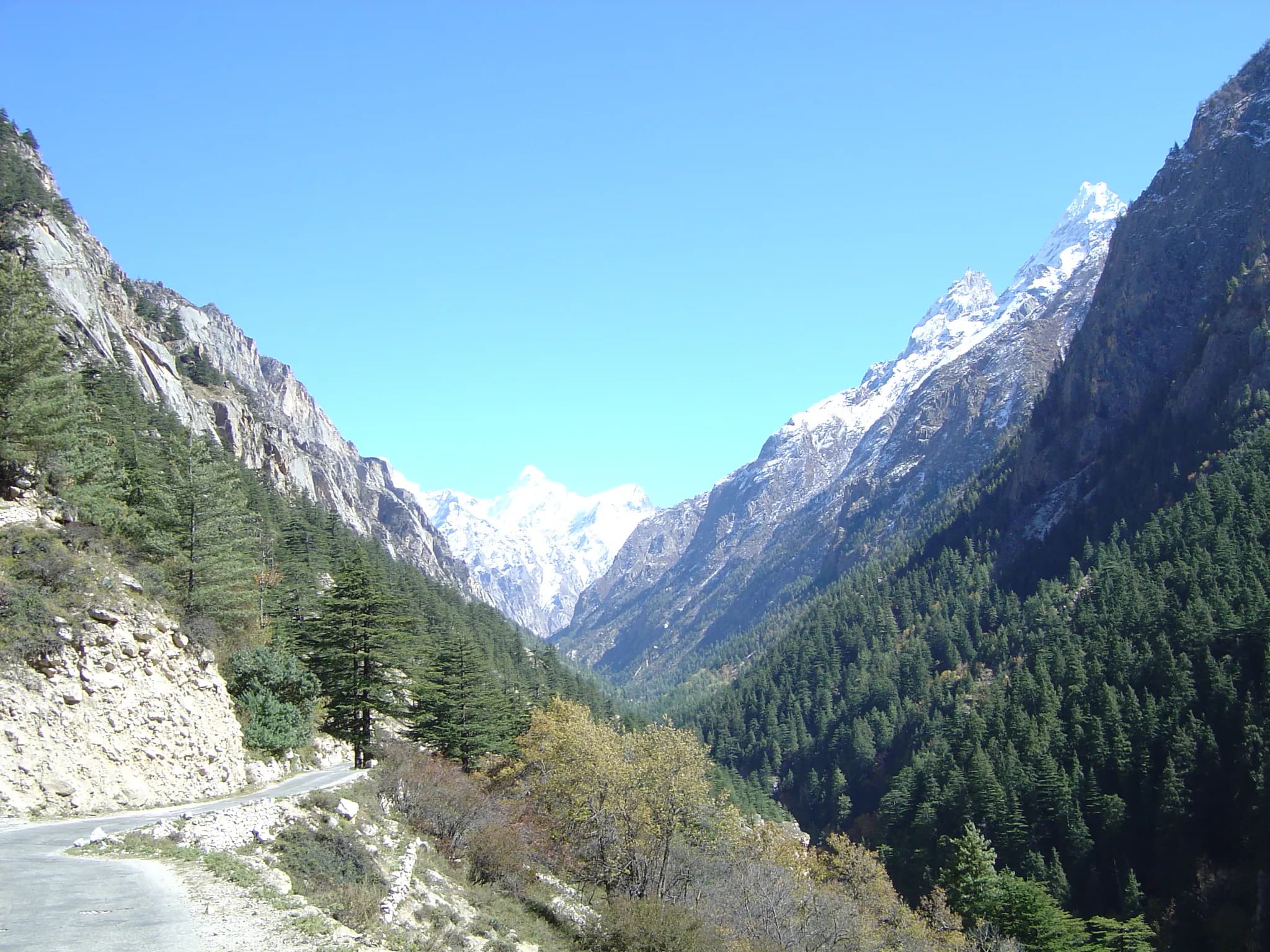
Featured
80% Documented
Gangotri, Uttarkashi, Gangotri (249135), Uttarakhand, India, Uttarakhand
The glacial chill of the Bhagirathi River, roaring just a few meters away, seemed to permeate the very stones of the Gangotri Temple. Standing before this pristine white structure, nestled amidst the towering Himalayas, I felt a palpable shift from the Dravidian temple architecture I'm so accustomed to in Chennai. Here, the simplicity and almost austere elegance of the Gangotri Temple spoke a different architectural language, a testament to the resilience of faith in this harsh, yet breathtaking landscape. Built in the 18th century by the Gorkha General Amar Singh Thapa, the temple lacks the elaborate ornamentation and towering gopurams that characterize South Indian temples. Its two-story structure, constructed primarily of granite, is relatively small in scale, yet its presence is magnified by the sheer grandeur of its surroundings. The sloping roof, clad in sheets of copper, is a distinct feature, a practical adaptation to the heavy snowfall this region experiences. This contrasts sharply with the granite and sandstone vimanas of the south, designed to withstand torrential monsoons. Entering the sanctum sanctorum, I was struck by the reverence that permeated the air. The deity, Goddess Ganga, is depicted in a silver palanquin, a stark departure from the intricately carved stone idols I'm familiar with. The simplicity of the iconography, however, seemed to amplify the spiritual energy within the temple. The lack of elaborate carvings within the sanctum allowed the focus to remain solely on the goddess, fostering a sense of direct connection with the divine. Stepping back outside, I began to appreciate the subtle nuances of the temple's design. The lack of extensive sculptural programs, common in Dravidian architecture, allows the natural beauty of the surrounding landscape to become an integral part of the temple experience. The snow-capped peaks, the roaring river, and the crisp mountain air all contribute to a sense of awe and reverence. This integration of the natural world with the built environment is a hallmark of Himalayan temple architecture, a stark contrast to the often self-contained temple complexes of the south. I observed a few pilgrims performing parikrama around the temple. The circumambulatory path, unlike the wide prakarams of Southern temples, was a simple, paved walkway. This again highlighted the emphasis on functionality and adaptation to the environment. The temple's design prioritizes accessibility and practicality, reflecting the challenging terrain and weather conditions. The use of granite for the temple's construction is also noteworthy. While granite is used in South Indian temples, particularly for the base and pillars, the extensive use of this material at Gangotri speaks to its local availability and durability in this mountainous region. The gleaming white granite, set against the backdrop of the grey mountains and the turquoise river, creates a visually stunning contrast. One aspect that particularly intrigued me was the absence of a dedicated mandapam or pillared hall, a ubiquitous feature in South Indian temples. This absence, I believe, stems from the climatic conditions. A large open hall would be impractical in a region that experiences heavy snowfall. The temple's design, therefore, prioritizes enclosed spaces for warmth and protection from the elements. My visit to the Gangotri Temple was a profound experience, offering a fresh perspective on sacred architecture. It underscored the fact that architectural styles are not merely aesthetic choices but are deeply intertwined with the environment, the local culture, and the practical needs of the community. While the Dravidian temples of my homeland celebrate ornamentation and intricate detail, the Gangotri Temple, in its elegant simplicity, embodies a different kind of beauty, a beauty born of resilience, adaptation, and a deep reverence for the natural world. It stands as a testament to the enduring power of faith, expressed through architecture that harmonizes with its surroundings, creating a sacred space that resonates with the very soul of the Himalayas.
Temple
British Colonial Period
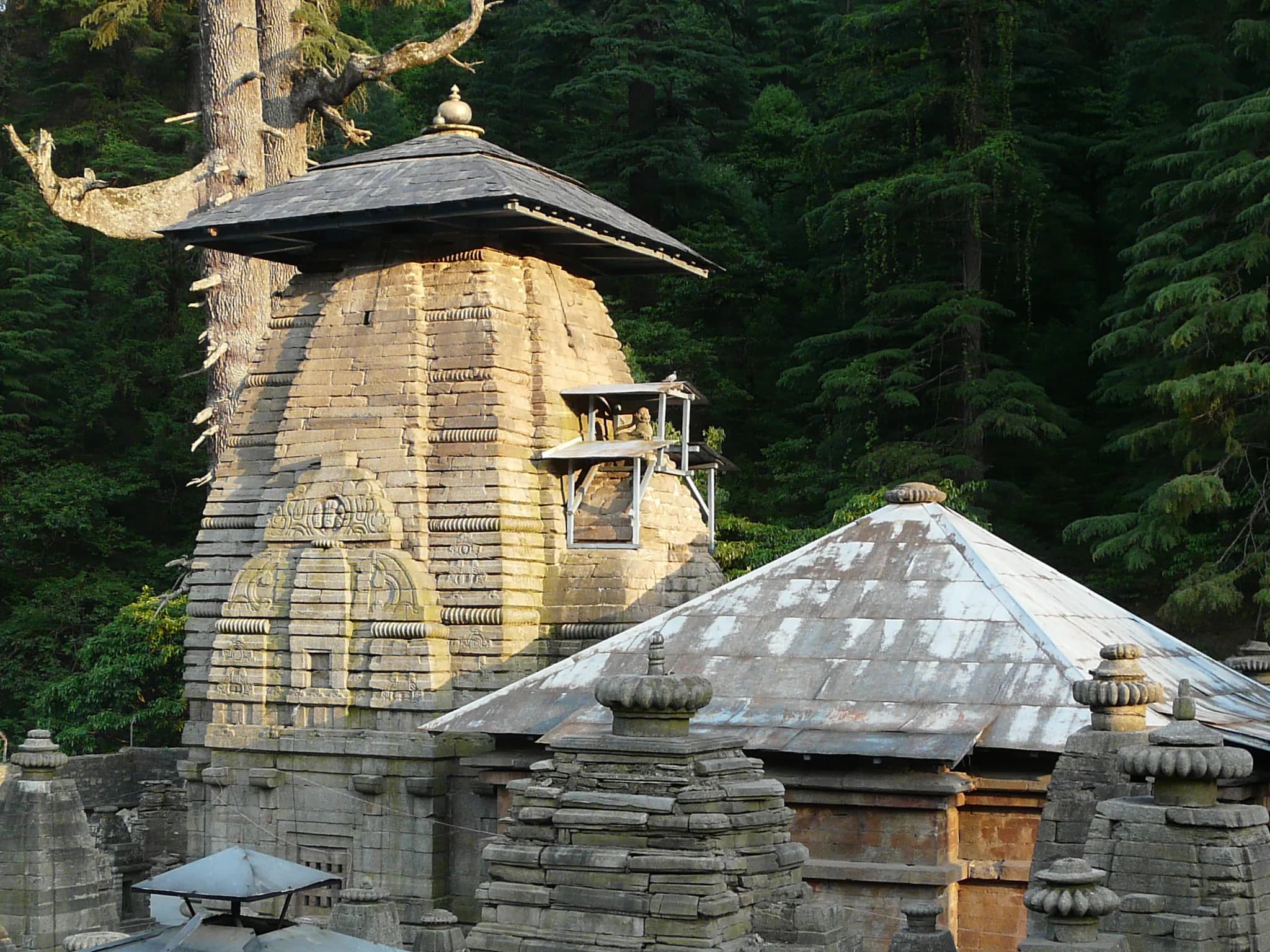
Featured
80% Documented
Jageshwar, Almora, Jageshwar (263634), Uttarakhand, India, Uttarakhand
The crisp mountain air of Uttarakhand carried the scent of pine and something older, something sacred. I stood at the entrance to the Jageshwar temple complex, a sprawling tapestry of over 124 stone temples nestled within a deodar forest. It wasn't simply a collection of structures; it felt like stepping into a living, breathing organism that had evolved organically over centuries. The Jageshwar group isn't a planned, symmetrical layout like Khajuraho or Modhera; it's a cluster, a family of shrines that have grown around each other, whispering stories of devotion and architectural ingenuity. My initial impression was one of subdued grandeur. Unlike the towering, imposing structures of South India, these temples were more intimate, their grey stone surfaces softened by moss and lichen. The majority of the temples belong to the Nagara style of North Indian architecture, characterized by a curvilinear shikhara, the tower above the sanctum. However, the shikharas here possess a distinct local flavour. They are taller and more slender than those found in, say, Odisha, giving them an almost ethereal quality against the backdrop of the Himalayas. Several temples, particularly the larger ones dedicated to Jageshwar (Shiva) and Mrityunjaya, exhibit the classic tiered structure of the shikhara, with miniature replicas of the main tower adorning each level, diminishing in size as they ascend towards the finial. I spent hours wandering through the complex, tracing the weathered carvings on the doorways and pillars. The intricate detailing, though eroded by time and the elements, still spoke volumes of the skill of the artisans. Recurring motifs included stylized lotuses, geometric patterns, and depictions of divine figures – Shiva, Parvati, and Ganesha being the most prominent. One particular panel, on a smaller shrine dedicated to Nandi, caught my attention. It depicted a scene from Shiva's marriage to Parvati, the figures rendered with a surprising dynamism, their expressions almost palpable despite the wear and tear. The main Jageshwar temple, dedicated to the eponymous deity, is the largest and arguably the most impressive. Its towering shikhara dominates the skyline of the complex, drawing the eye upwards. Inside the sanctum, a lingam, the aniconic representation of Shiva, resides in a dimly lit chamber, imbued with a palpable sense of reverence. The air was thick with the scent of incense and the murmur of prayers, a testament to the fact that this is not merely an archaeological site but a living place of worship. What struck me most about Jageshwar was the sense of continuity. The architectural styles evident here span several centuries, from the early Gupta period to the later medieval era. You can trace the evolution of the Nagara style, observing the subtle changes in the shikhara design, the ornamentation, and the layout of the temples. This layering of history, this palpable connection to the past, is what sets Jageshwar apart. It's not a static museum piece; it's a dynamic testament to the enduring power of faith and the artistry of generations of builders. As the sun began to dip behind the mountains, casting long shadows across the complex, I felt a profound sense of peace. Jageshwar is more than just a collection of temples; it's a sanctuary, a place where the whispers of the past mingle with the prayers of the present. It's a place that reminds us of the enduring power of human creativity and the timeless search for the divine. And it's a place that I, as a student of ancient Indian architecture, will carry with me, etched in my memory, for years to come.
Temple
Gurjara-Pratihara Period
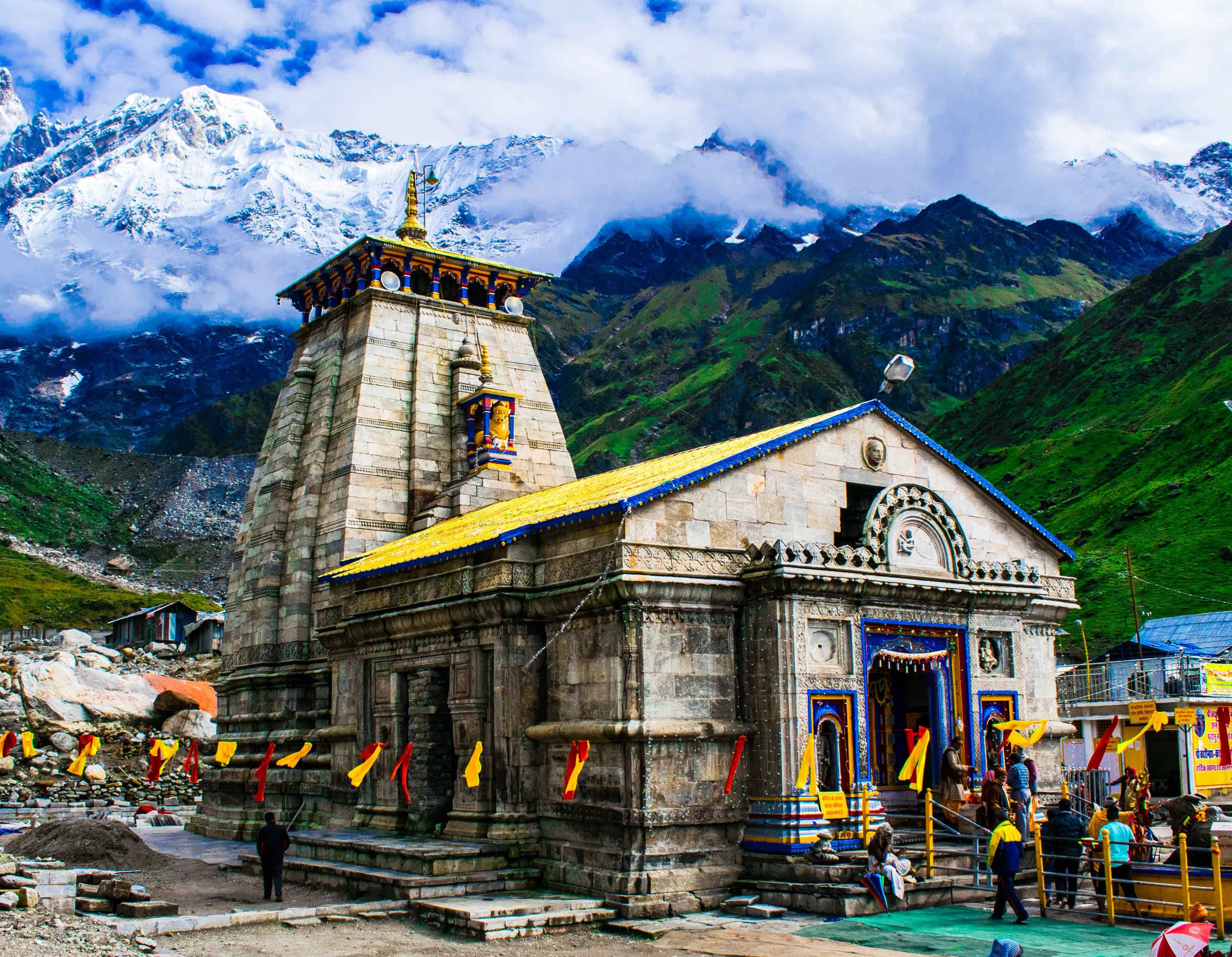
Featured
85% Documented
Kedarnath, Rudraprayag, Kedarnath (246445), Uttarakhand, India, Uttarakhand
The biting Himalayan wind whipped prayer flags into a frenzy around me, their vibrant colours a stark contrast to the grey, imposing stone of the Kedarnath Temple. Standing at an altitude of over 11,755 feet, surrounded by snow-capped peaks, the sheer resilience of this ancient structure took my breath away, even more so than the thin mountain air. My journey from Uttar Pradesh, traversing the winding roads and steep inclines, felt like a pilgrimage through time, connecting me to the deep spiritual roots of my own region. The temple, dedicated to Lord Shiva in his Kedarnath form, exudes an aura of timeless devotion. Its architecture, typical of the North Indian Himalayan style, is a testament to the ingenuity of the craftsmen who built it centuries ago. The thick, grey stone walls, built to withstand the harsh weather, are adorned with intricate carvings, weathered by time but still retaining a remarkable clarity. I ran my hand over the cool stone, tracing the outlines of deities and mythical creatures, feeling a palpable connection to the generations of pilgrims who had done the same. The main entrance, a relatively small wooden door, almost feels understated given the grandeur of the temple itself. Stepping inside, the dimly lit sanctum sanctorum offers a stark contrast to the bright exterior. The air is thick with the scent of incense and the murmur of prayers. The conical-shaped lingam, the symbolic representation of Lord Shiva, dominates the space, its dark, smooth surface worn smooth by centuries of reverence. I watched as devotees offered flowers, whispered prayers, and performed rituals, their faces etched with a profound sense of devotion. The energy within the sanctum is palpable, a blend of reverence, hope, and the quiet hum of spiritual energy. Outside, the temple complex is a bustling hub of activity. Priests perform rituals, pilgrims circumambulate the temple, and vendors sell religious paraphernalia. Despite the commercial activity, the atmosphere remains deeply spiritual. The backdrop of the majestic Himalayas, the constant chime of temple bells, and the palpable faith of the devotees create an environment unlike any other. What struck me most about Kedarnath was not just its religious significance, but also its historical and cultural context. Having studied the history of Uttar Pradesh, I recognized the influence of the region's architectural styles and religious practices in the temple's design and rituals. The intricate carvings, the use of specific materials, and the reverence for Lord Shiva all echoed the cultural landscape of my own homeland. It highlighted the interconnectedness of the Himalayan region and the flow of cultural and spiritual influences across these mountainous terrains. The 2013 floods, which devastated the region, left their mark on Kedarnath. While the temple itself miraculously survived, the surrounding area suffered significant damage. Evidence of the disaster is still visible, a stark reminder of the power of nature and the fragility of human endeavors. However, the resilience of the local community and the unwavering faith of the pilgrims are equally evident. The rebuilding efforts, the renewed influx of devotees, and the unwavering spirit of the place speak volumes about the enduring power of faith and the human capacity for recovery. As I descended from Kedarnath, the image of the temple, silhouetted against the snow-capped peaks, remained etched in my mind. The journey had been more than just a reporting assignment; it was a deeply personal experience. It was a journey into the heart of the Himalayas, a journey into the heart of faith, and a journey into the rich cultural tapestry of my own heritage. The echoes of chants, the scent of incense, and the feel of the ancient stone beneath my fingertips – these are the sensory memories I carry with me, a testament to the enduring power of Kedarnath.
Temple
Gurjara-Pratihara Period
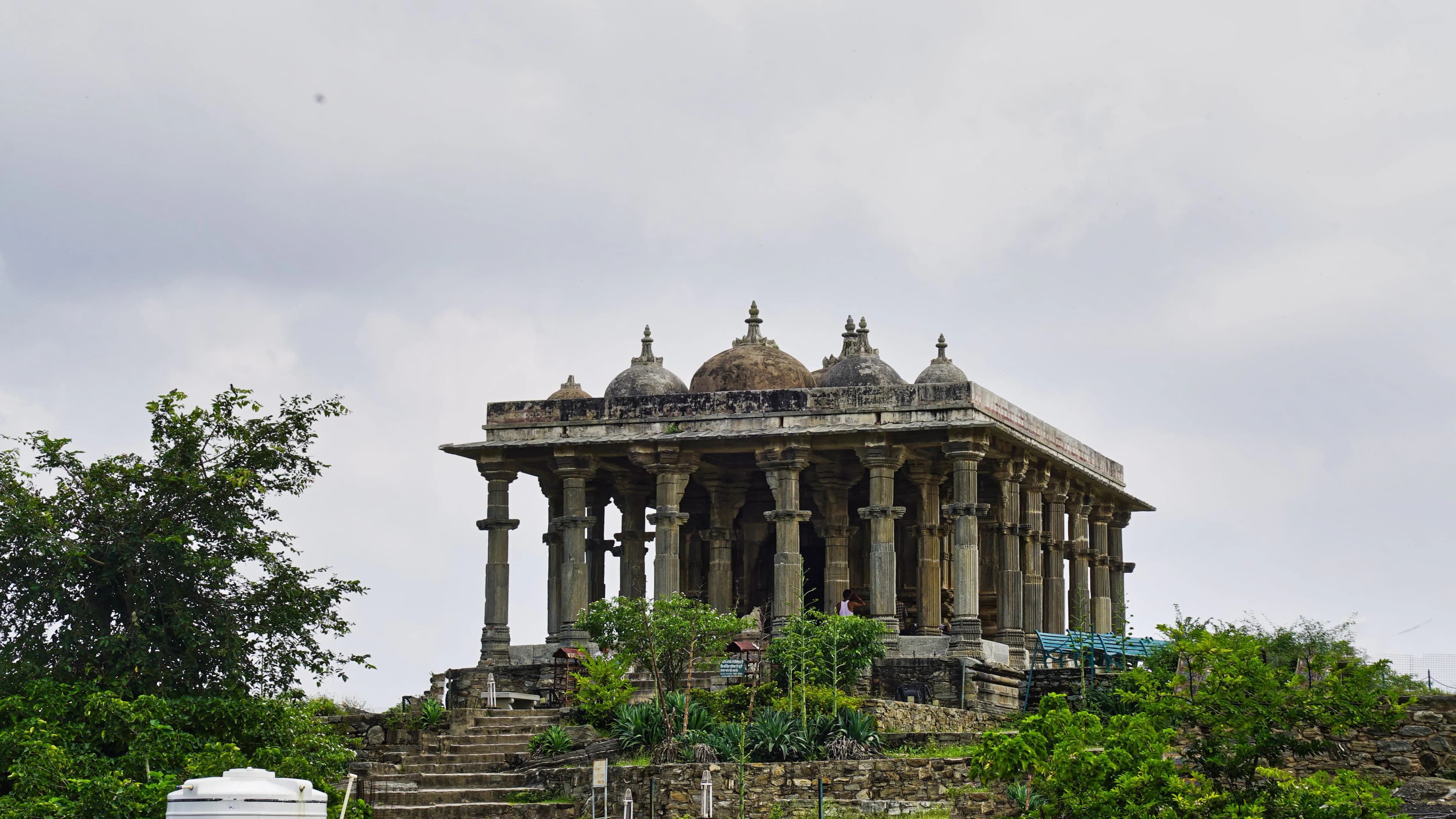
Featured
80% Documented
Neelkanth Road, Pauri Garhwal, Rishikesh (249304), Uttarakhand, India, Uttarakhand
The roar of the Panch Ganga reverberated through the narrow gorge, a constant, powerful undercurrent to the peace I sought at the Neelkanth Mahadev Temple. Nestled amidst dense deodar forests in the Garhwal Himalayas, the temple, dedicated to Lord Shiva, felt both ancient and vibrantly alive. The journey itself was a pilgrimage of sorts, winding uphill through hairpin bends, each turn revealing a more breathtaking vista of the verdant valley below. The temple's location is no accident. It's believed to be the exact spot where Lord Shiva consumed the poison that emerged during the churning of the cosmic ocean (Samudra Manthan), turning his throat blue – hence the name Neelkanth, meaning "blue throat." This potent mythology imbues the air with a palpable sense of reverence. As I approached the temple, the first thing that struck me was its vibrant architecture. Unlike the sandstone structures prevalent in my home state of Madhya Pradesh, Neelkanth is built of grey stone, a material choice that blends seamlessly with the surrounding landscape. The shikhara, though not towering, possesses a distinct curvilinear grace, adorned with intricate carvings of deities and mythical creatures. The vibrant colours used to paint these figures – deep reds, blues, and yellows – popped against the grey stone, creating a visual feast. I spent considerable time documenting the weathered patina of the stone, capturing how centuries of sun, rain, and devotion had etched their stories onto the temple walls. The main entrance is guarded by two imposing stone lions, their expressions a curious blend of ferocity and serenity. Stepping inside the courtyard, I was greeted by a scene of quiet devotion. Devotees offered prayers, the air thick with the scent of incense and the rhythmic chanting of mantras. The energy was palpable, a blend of ancient ritual and contemporary faith. My lens was drawn to the intricate details: the ornate brass bells hanging from the eaves, the meticulously carved pillars supporting the mandap, and the worn stone steps leading to the sanctum sanctorum. I noticed how the natural light filtering through the trees dappled the courtyard, creating an ethereal atmosphere. It was a photographer's dream, each angle offering a new perspective on the temple's beauty. Inside the garbhagriha, the inner sanctum, photography was prohibited. But the memory of that brief glimpse remains etched in my mind. The lingam, representing Lord Shiva, was bathed in the soft glow of oil lamps, the air heavy with the fragrance of flowers and sandalwood. The hushed reverence of the devotees was contagious, and even I, behind my lens, felt a sense of profound peace. Beyond the main temple structure, I explored the surrounding area. A natural spring, believed to be sacred, flows nearby, its water considered holy by the devotees. I observed how people queued patiently to collect the water, their faces reflecting a deep faith. The surrounding forest, with its towering deodar trees and the constant murmur of the Panch Ganga, added to the sense of tranquility. My time at Neelkanth Mahadev Temple was more than just a photographic assignment; it was a spiritual experience. The temple's architecture, its location, and the palpable devotion of the pilgrims combined to create an atmosphere of profound peace and reverence. As I descended the winding mountain road, I carried with me not just photographs, but a renewed appreciation for the power of faith and the enduring beauty of India's ancient heritage. The roar of the Panch Ganga, now fading in the distance, seemed to carry with it the echoes of ancient prayers, a constant reminder of the sacred ground I had just left behind.
Temple
Gurjara-Pratihara Period
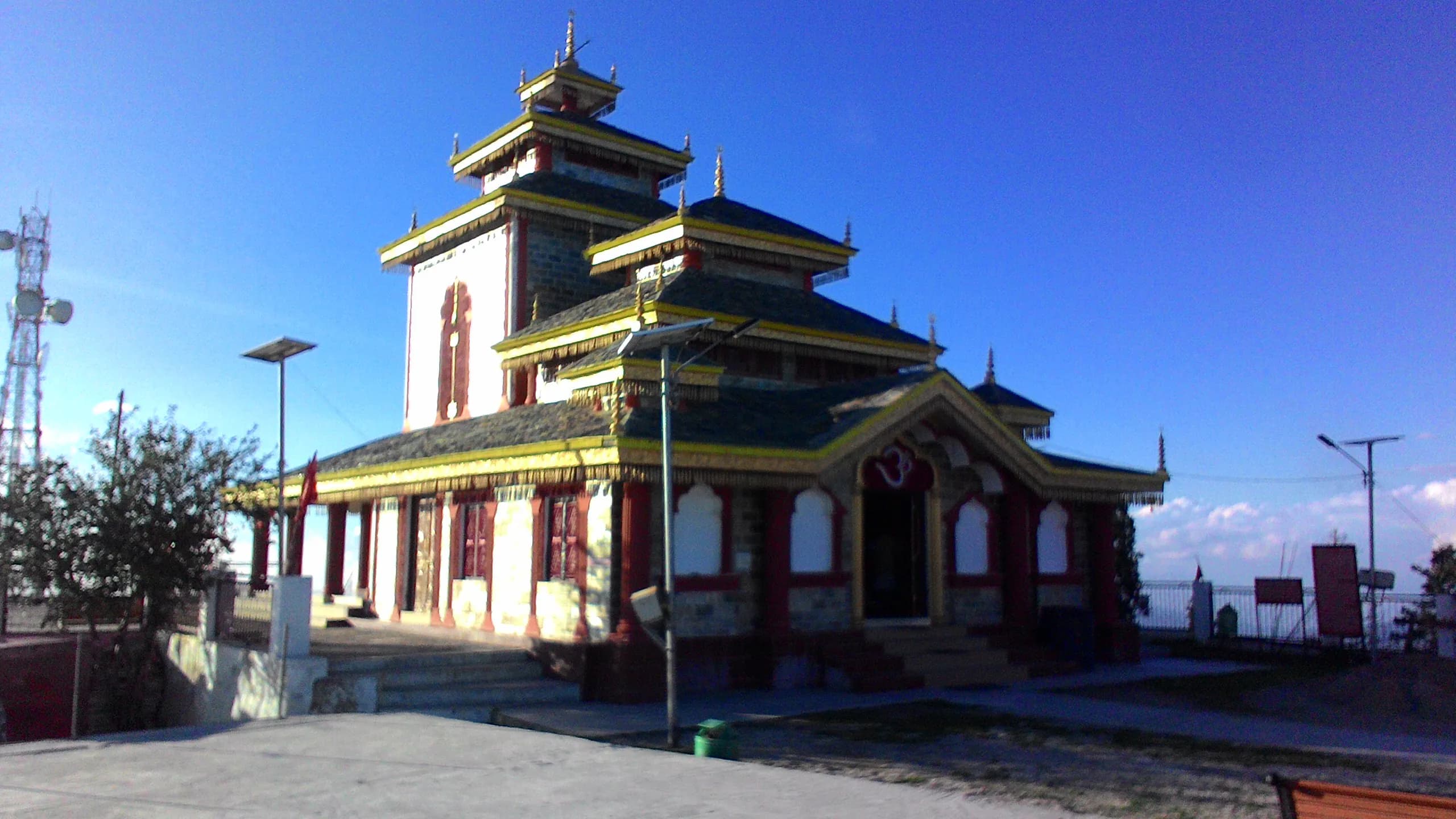
Featured
80% Documented
Surkanda Devi Road, Tehri Garhwal, Dhanaulti (249175), Uttarakhand, India, Uttarakhand
The crisp mountain air, scented with pine and a hint of woodsmoke, whipped around me as I ascended the final steps to Surkanda Devi Temple. Perched at an altitude of almost 10,000 feet in the Tehri Garhwal district of Uttarakhand, the temple commands a breathtaking panorama of the Himalayan peaks. It's a view that instantly justifies the arduous journey, a blend of winding roads and a steep, albeit scenic, climb. My camera, a constant companion, felt almost inadequate to capture the grandeur of the snow-capped giants against the azure sky. Surkanda Devi, dedicated to the goddess Sati, holds a profound significance in Hindu mythology. Local legend recounts this spot as the place where Sati's head fell after she self-immolated. This narrative imbues the location with a palpable sense of reverence, a quiet energy that hums beneath the surface of the bustling activity of pilgrims. The temple itself is relatively small, a stark contrast to the vastness of the landscape it inhabits. Its architecture is a simple yet elegant example of traditional Himalayan temple design. The main shrine, constructed of grey stone, features a sloping slate roof adorned with a golden trident, glinting in the sunlight. Unlike the ornate carvings found in many South Indian temples, the aesthetic here is one of understated beauty, allowing the natural surroundings to take center stage. I spent hours observing the intricate details. The stonework, though weathered by time and the elements, displayed a remarkable craftsmanship. The mortar, seemingly a simple mixture of lime and sand, had held the structure together for centuries, a testament to the ingenuity of the builders. Small brass bells, tied to the eaves, chimed melodiously in the wind, adding another layer to the sensory experience. Inside the sanctum sanctorum, photography is prohibited, a rule I respected. However, the memory of the dimly lit space, filled with the fragrance of incense and the murmur of prayers, remains vivid. The atmosphere was thick with devotion, a collective energy that transcended language and background. It was a privilege to witness this intimate expression of faith. Beyond the main shrine, the temple complex includes several smaller structures and open spaces. I noticed a series of small stone platforms, likely used for rituals. The surrounding walls were adorned with faded murals depicting scenes from Hindu mythology. These weathered paintings, though partially obscured by time, offered a glimpse into the rich artistic traditions of the region. I meticulously documented these fragments of history, hoping to preserve their stories through my lens. One of the most striking aspects of Surkanda Devi is the seamless integration of the built environment with the natural landscape. The temple seems to grow organically from the mountainside, a harmonious blend of human creation and nature's artistry. The panoramic views from the temple courtyard are simply mesmerizing. The rolling hills, blanketed in dense forests, stretch out as far as the eye can see, punctuated by the towering peaks of the Himalayas. As the sun began to dip below the horizon, casting long shadows across the valley, I felt a profound sense of peace. Surkanda Devi is more than just a temple; it's a sanctuary, a place where the spiritual and the natural converge. My experience here transcended the purely visual; it was a journey into the heart of the Himalayas, a testament to the enduring power of faith and the breathtaking beauty of the natural world. Leaving the temple, I carried with me not just photographs, but a deeper appreciation for the rich cultural and spiritual heritage of Uttarakhand.
Temple
Rajput Period
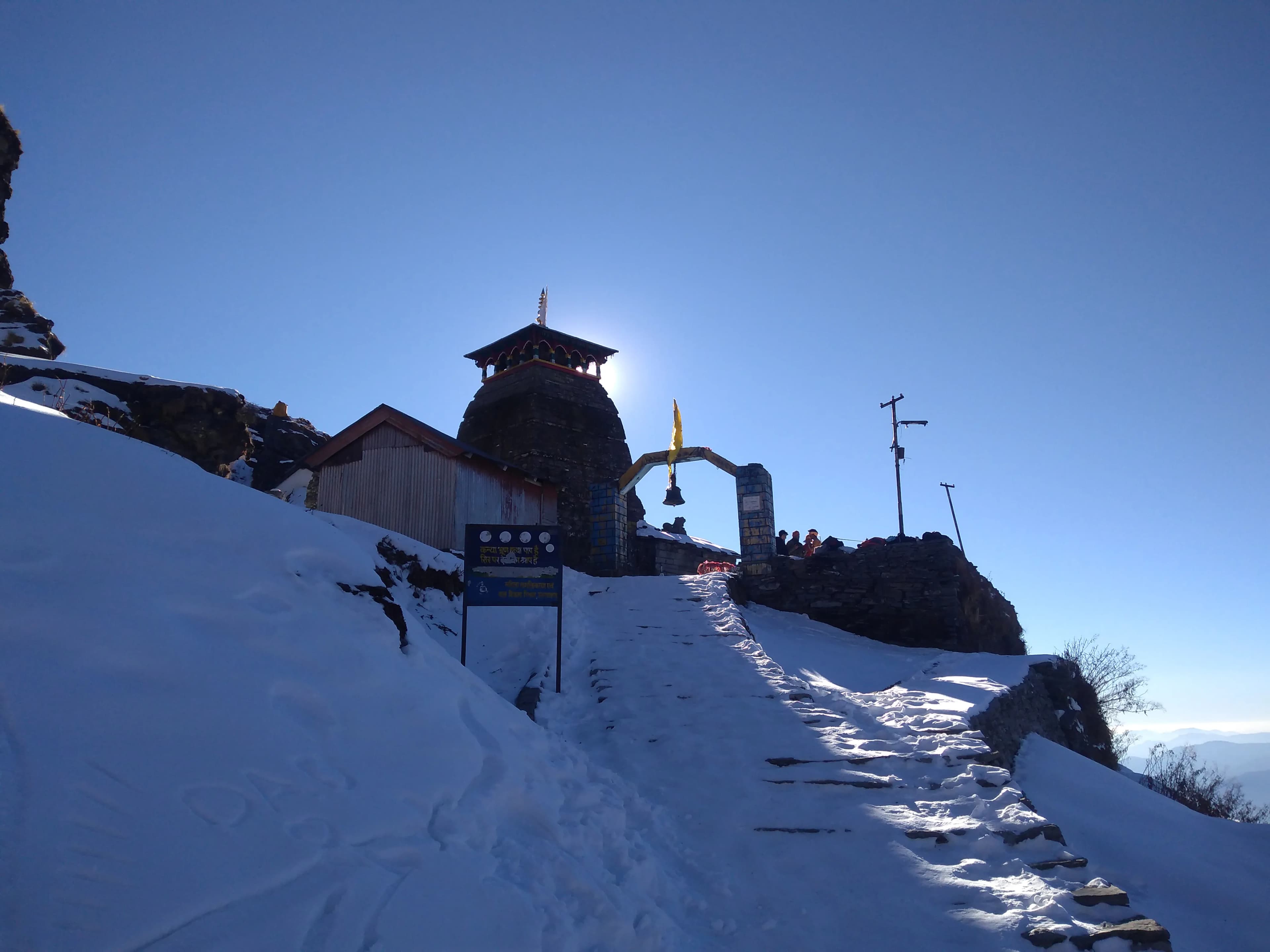
UNESCO
Featured
80% Documented
Chopta-Tungnath Road, Rudraprayag, Chopta (246419), Uttarakhand, India, Uttarakhand
The biting wind whipped at my shawl as I crested Chandrashila peak, the snow-capped Himalayas stretching out before me like a rumpled white sheet. Below, nestled amongst the undulating brown hills, sat Tungnath, the highest Shiva temple in the world. Having explored countless forts and palaces back in Rajasthan, I was eager to experience this unique high-altitude shrine, a stark contrast to the desert architecture I was accustomed to. The trek down from Chandrashila was steep, the path winding through alpine meadows still dotted with patches of snow despite it being late spring. The air was thin, each breath a conscious effort, but the anticipation of reaching Tungnath spurred me onward. The temple finally came into full view, a small, unassuming stone structure, dwarfed by the majestic peaks surrounding it. Its simplicity was striking, a far cry from the ornate carvings and sprawling complexes of Rajasthan's temples. Built of grey stone, the temple’s architecture reflects the North Indian style, a compact square structure with a sloping roof. Unlike the sandstone and marble I was used to, the stone here felt ancient, weathered smooth by centuries of harsh weather. The small wooden door, studded with iron, seemed almost too modest for a deity of Shiva's stature. Entering, I found myself in a dimly lit sanctum. The air was thick with the scent of incense and the murmur of prayers. The small Shiva lingam, the object of worship, resided at the center, worn smooth by the touch of countless devotees. The walls, though plain, bore witness to the passage of time, with faint traces of what might have once been intricate carvings, now lost to the elements. The priest, bundled in layers of wool, performed the rituals with a practiced ease, his voice resonating in the small space. The handful of other pilgrims present, their faces flushed from the climb, radiated a quiet devotion. There was a palpable sense of peace here, a serenity that transcended the physical hardships of the journey. Stepping back outside, I circumambulated the temple, the wind now a constant companion. The panoramic views from this vantage point were breathtaking. The snow-capped peaks of Nanda Devi, Trishul, and Kedarnath pierced the azure sky, their icy slopes gleaming in the afternoon sun. It was easy to understand why this remote location was chosen as a place of worship. The raw, untamed beauty of the Himalayas felt profoundly spiritual, a fitting backdrop for a temple dedicated to the god of destruction and creation. The architecture of Tungnath, while simple, is remarkably resilient. The interlocking stones, held together without mortar, have withstood centuries of harsh weather, a testament to the ingenuity of the builders. The small size of the temple, perhaps dictated by the challenging terrain, adds to its charm, creating an intimate space for worship. It stands in stark contrast to the grand temples of Rajasthan, a reminder that spirituality isn't confined to elaborate structures but can be found in the most austere of settings. As I began my descent, I couldn't help but feel a sense of awe. Tungnath is more than just a temple; it's an experience. The arduous trek, the breathtaking views, the simple yet powerful architecture, and the palpable sense of devotion combine to create something truly unique. It's a place where the earth meets the sky, where the physical and the spiritual converge, leaving an indelible mark on the soul of every visitor. It reminded me that while the architectural expressions of faith may differ across India, the underlying devotion remains the same, a powerful force that draws people to these sacred spaces, be it a desert fort or a Himalayan peak.
Temple
North Indian Temple Style
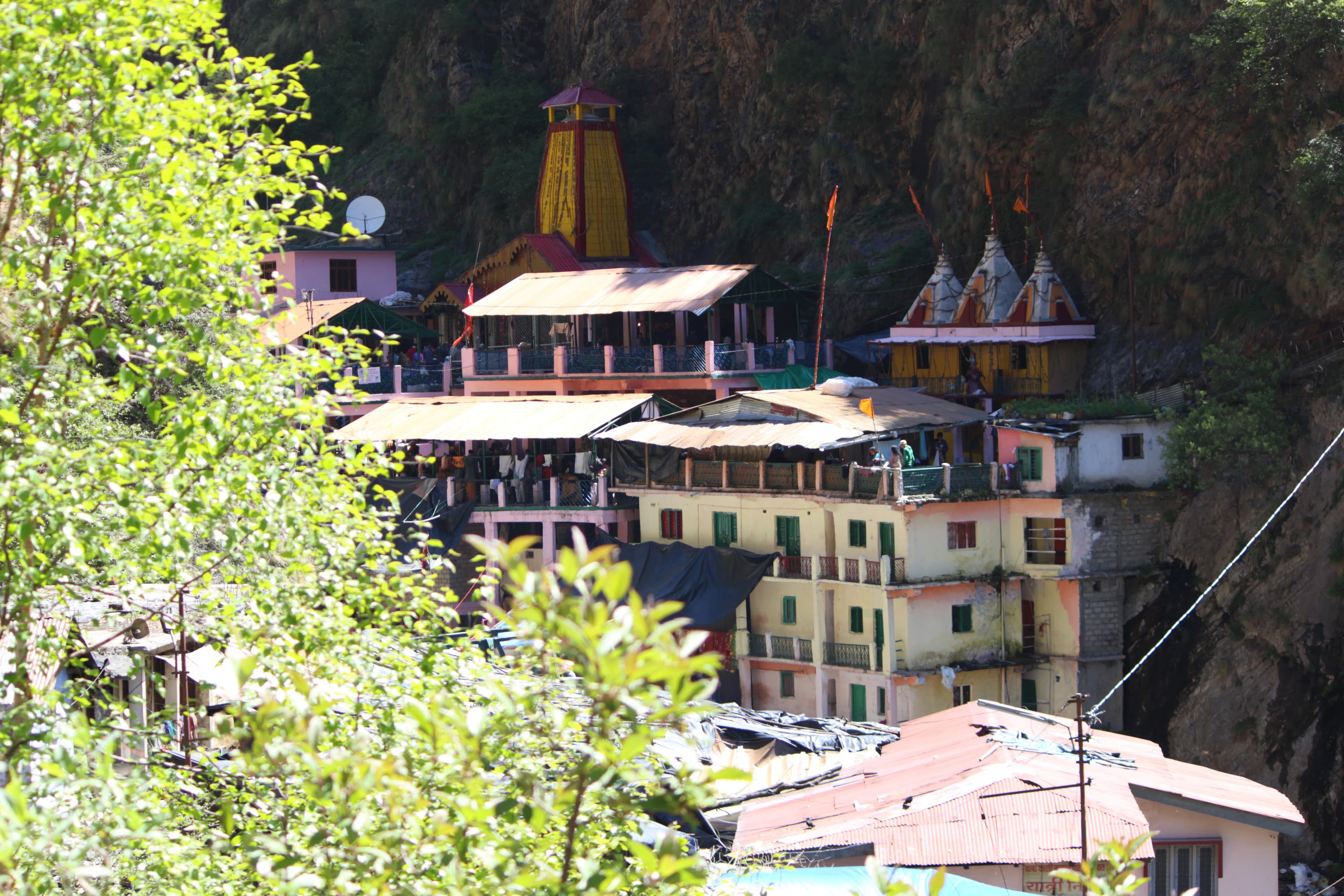
UNESCO
Featured
80% Documented
Kharsali, Uttarkashi, Yamunotri (249141), Uttarakhand, India, Uttarakhand
The biting Himalayan wind whipped around me, a stark contrast to the warmth radiating from the heart of Yamunotri. Here, nestled amidst snow-capped peaks in Uttarakhand's Uttarkashi district, stands the modest yet magnificent Yamunotri Temple, the source of the revered Yamuna River. My journey from the sun-drenched landscapes of Gujarat to this icy abode of the Goddess Yamuna was a pilgrimage not just of faith, but of architectural discovery. The temple, constructed primarily of granite, stands as a testament to resilience against the harsh elements. Its simple, almost austere design, is a departure from the ornate temples I'm accustomed to back home. The stark white facade, punctuated by a vibrant orange roof, creates a striking visual against the backdrop of grey mountains and verdant pine forests. The structure is relatively small, almost intimate, allowing devotees to feel a close connection with the deity. I noticed the meticulous craftsmanship in the granite blocks, fitted together with precision, a feat considering the challenging terrain and weather conditions. The absence of elaborate carvings, common in Gujarati temples, allows the natural beauty of the stone to shine through. The temple’s resilience is evident; it has withstood centuries of harsh winters, avalanches, and earthquakes, each time being rebuilt with unwavering devotion. Inside the sanctum sanctorum resides the black marble idol of Goddess Yamuna, radiating a serene aura. The energy within the temple is palpable, a blend of reverence and the raw power of nature. Unlike the bustling temple complexes of Gujarat, Yamunotri offers a sense of quiet contemplation. The focus remains solely on the Goddess and the sacred source of the Yamuna. Just a few meters away from the temple, bubbling from the mountainside, is the actual source of the Yamuna – the Yamunotri glacier. Witnessing this glacial stream, the birthplace of a river that nourishes millions, was a profoundly moving experience. The icy water, even at its source, held a surprising warmth. Devotees were taking a holy dip in the nearby Surya Kund, a thermal spring where they also boil rice and potatoes as prasad, a ritual I observed with fascination. The juxtaposition of the icy river and the boiling hot spring is a testament to the fascinating interplay of nature's forces. The trek to the temple itself is an architectural marvel of a different kind. The paved pathway, though steep in parts, is a testament to human ingenuity and perseverance. The route is dotted with small shrines and rest stops, offering glimpses of local architecture and providing respite to weary pilgrims. I observed the clever use of local materials like wood and stone in these structures, blending seamlessly with the surrounding landscape. One particular architectural element that caught my eye was the use of dry stone walling along the trek. These walls, built without mortar, are a testament to the ingenuity of the local communities. They serve as retaining walls, preventing landslides and protecting the pathway. The intricate patterns formed by the carefully placed stones are a testament to the aesthetic sensibilities of the builders. As I descended from Yamunotri, I carried with me not just the memory of a sacred pilgrimage, but also a deep appreciation for the unique architectural heritage of the Himalayas. The Yamunotri Temple, in its simplicity and resilience, stands as a powerful symbol of faith and human connection with nature. It is a stark contrast to the architectural exuberance of my homeland, yet equally captivating. The experience reinforced the understanding that architecture, in its diverse forms, reflects the spirit of a place and its people. The quiet strength of Yamunotri's architecture spoke volumes, a silent testament to the enduring power of faith and the awe-inspiring beauty of the Himalayas.
Temple
Rajput Period
Related Collections
Discover more heritage sites with these related collections
Explore More Heritage
Start exploring! Click on any heritage site to view visiting hours, entry fees, how to reach, best photography spots, and local experiences.